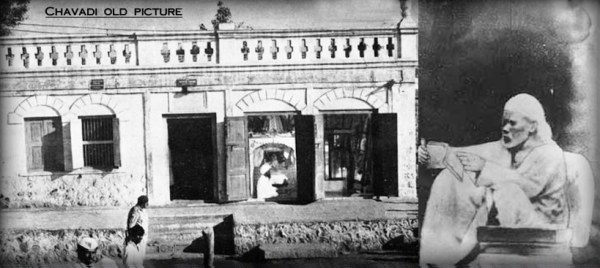Sree Chavadi
Shirdi Saibaba used to sleep in chavadi
Shirdi Saibaba Chavadi
Though apparently and formally Baba used to go to the Chavadi. In his super conscious state he was never asleep and used to tell his devotees that in his everlasting awareness (consciousness) he will always protect his devotees who were asleep at night.
Chavadi means “village office”, and was the place where taxes were collected, village records kept and visiting officials put up. After Baba’s mahasamadhi the Sansthan acquired Chavadi, and until the late 1930s, used it for storing books and accommodating pilgrims. The village offices have long been relocated and Chavadi is kept as a shrine to Baba and is open to all.
Sai Baba is intimately connected with this place, as he used to sleep here on alternate nights, during the last decade of his life. The routine was started on one wild and stormy night, around 1909. It was raining heavily, and water was coming through the leaky walls of the mosque. The devotees tried their best to persuade Baba to move out, if only until the water had subsided, but Baba did not want to go. Eventually, they virtually forced him to leave, by picking him up and half-carrying him to Chavadi. From that day onwards, Baba would spend alternate nights here.
Chavadi is also very significant to Sai devotees as it played a major role in the inception of formal worship of Baba. Once Baba started sleeping at Chavadi, the custom arose of offering regular arati to him on his arrival from the mosque. This was Sej (night) Arati. Later, Kakad (morning) Arati was offered when he woke up there. The performance of Midday and Evening aratis at the mosque probably developed subsequently.
Around the time that Dwarkamai was renovated, Chavadi was also upgraded. The mud walls were neatly plastered, huge mirrors were hung, glazed tiles replaced the mud floor and glass chandeliers were suspended from the ceiling. The funding for the renovations was provided by Anna Chinchanikar, who was deeply devoted to Baba. He had been involved in a land dispute and after a protracted struggle, during which he repeatedly asked Baba about the outcome, he was elated when the court ruled in his favour. Feeling that the triumph was purely due to Baba’s grace, he very much wanted to give Baba the full sum awarded. Baba, however, refused it and Dixit suggested that the money be spent on Chavadi and named after Chinchanikar and his wife. Consequently, their names are inscribed (in Marathi) on a plaque above the doorway. The sitting platform along the outside of the front wall is a later addition.
Inside Chavadi is a large portrait of Baba which was painted by Ambaram from Nausari in Gujarat after Baba had given him darshan in a dream in 1953. At the time, Ambaram was only eighteen years old. The Nausari villagers were touched by Baba and Ambaram’s painting of him, so they collected donations in order to buy it and bring it to Shirdi.
On the left of the painting is a plain, wooden bed on which Baba was given his last bath after he passed away in Dwarkamai. These days, the bed is taken out each thursday and the palanquin is placed on it. In the same corner next to the bed is a wheelchair which was presented to Baba when he was suffering from asthma, but which he never used.
The right portion of the building contains the framed photo of the cross-legged Baba kept in grand attire (hence it is known as the raj upachar photo) and this is the picture that is taken out on procession on festivals on each thursday. The silver throne where it is kept is where Baba used to sleep. Women were not allowed in this section and this tradition is maintained today; only men and children are allowed in this area.
Chavadi is open from 3.45 a.m. to 9.00 p.m.
Shirdi Saibaba Chavadi
Though apparently and formally Baba used to go to the Chavadi. In his super conscious state he was never asleep and used to tell his devotees that in his everlasting awareness (consciousness) he will always protect his devotees who were asleep at night.
Chavadi means “village office”, and was the place where taxes were collected, village records kept and visiting officials put up. After Baba’s mahasamadhi the Sansthan acquired Chavadi, and until the late 1930s, used it for storing books and accommodating pilgrims. The village offices have long been relocated and Chavadi is kept as a shrine to Baba and is open to all.
Sai Baba is intimately connected with this place, as he used to sleep here on alternate nights, during the last decade of his life. The routine was started on one wild and stormy night, around 1909. It was raining heavily, and water was coming through the leaky walls of the mosque. The devotees tried their best to persuade Baba to move out, if only until the water had subsided, but Baba did not want to go. Eventually, they virtually forced him to leave, by picking him up and half-carrying him to Chavadi. From that day onwards, Baba would spend alternate nights here.
Chavadi is also very significant to Sai devotees as it played a major role in the inception of formal worship of Baba. Once Baba started sleeping at Chavadi, the custom arose of offering regular arati to him on his arrival from the mosque. This was Sej (night) Arati. Later, Kakad (morning) Arati was offered when he woke up there. The performance of Midday and Evening aratis at the mosque probably developed subsequently.
Around the time that Dwarkamai was renovated, Chavadi was also upgraded. The mud walls were neatly plastered, huge mirrors were hung, glazed tiles replaced the mud floor and glass chandeliers were suspended from the ceiling. The funding for the renovations was provided by Anna Chinchanikar, who was deeply devoted to Baba. He had been involved in a land dispute and after a protracted struggle, during which he repeatedly asked Baba about the outcome, he was elated when the court ruled in his favour. Feeling that the triumph was purely due to Baba’s grace, he very much wanted to give Baba the full sum awarded. Baba, however, refused it and Dixit suggested that the money be spent on Chavadi and named after Chinchanikar and his wife. Consequently, their names are inscribed (in Marathi) on a plaque above the doorway. The sitting platform along the outside of the front wall is a later addition.
Inside Chavadi is a large portrait of Baba which was painted by Ambaram from Nausari in Gujarat after Baba had given him darshan in a dream in 1953. At the time, Ambaram was only eighteen years old. The Nausari villagers were touched by Baba and Ambaram’s painting of him, so they collected donations in order to buy it and bring it to Shirdi.
On the left of the painting is a plain, wooden bed on which Baba was given his last bath after he passed away in Dwarkamai. These days, the bed is taken out each thursday and the palanquin is placed on it. In the same corner next to the bed is a wheelchair which was presented to Baba when he was suffering from asthma, but which he never used.
The right portion of the building contains the framed photo of the cross-legged Baba kept in grand attire (hence it is known as the raj upachar photo) and this is the picture that is taken out on procession on festivals on each thursday. The silver throne where it is kept is where Baba used to sleep. Women were not allowed in this section and this tradition is maintained today; only men and children are allowed in this area.
Chavadi is open from 3.45 a.m. to 9.00 p.m.
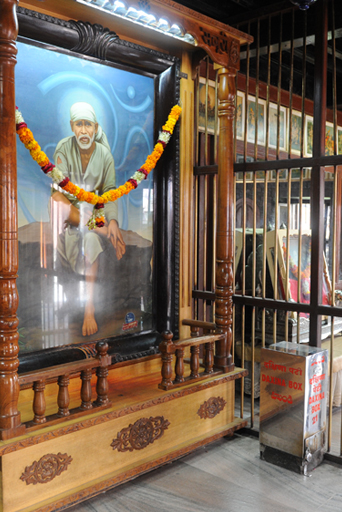
The Chavadi Procession (Utsav): This procession (palkhi) is the only ‘authentic’ and traditional procession of Baba’s padukas and photograph – from Masjeed (Dwarkamai) to chavadi.
Over time, the moving from Dwarkamai to Chavadi took on the form of a grand affair. This was thanks largely to the efforts of Radhakrishnayi, who wanted Baba to be honoured as a Maharajah, and supplied all sorts of ceremonial regalia. With the bedecked horse Shyam Sunder leading the way, Baba followed with Tatya on one side and Mahalsapati on the other, walking on carpets laid on the path. A crowd of people accompanied them, singing bhajan and dancing, playing musical instruments, shouting Baba’s name, letting off fireworks, holding a silver umbrella over Baba, waving flags and fans, and chanting hari-nama. The distance of a few metres took up to three hours to cover. Years earlier, Baba had predicted such scenes when talking to a few devotees, “In Shirdi there will be huge storied buildings, grand processions will be held, and big men will come. Chariots, horses, elephants will come, guns will be fired…”
One cannot help marveling at Baba. We know that he did not like such pomp and paraphernalia and we have seen the importance to him of holy poverty (“faqiri”) and his reluctance to allow devotees to worship him, yet here he was allowing himself to be lead to Chavadi in an extravagant display of adoration. In describing the scene a few moments before the procession Hemadpant hints at Baba’s response. People were singing bhajan, some were decorating the palanquin, rows of oil lamps were burning, Shyam Sunder stood waiting fully decorated, “then Tatya Patil came to Baba with a party of men and asked him to get ready. Baba sat quiet in his place till Tatya came and helped him to get up by putting his arm under Baba’s armpit” (page 198, my italic). Clearly, Baba was not eagerly waiting to begin – in fact, we may sense a certain resignation – yet he went ahead with it not just once, but hundreds of times ! Again and again this scene was reenacted, and it is one replete with poignancy and poetic tension. A great saint, adored as a living deity, but to whom any personal worship was distasteful, yet allowing it out of love for his devotees and a sympathy for their human longings.
The Sri Sai Satcharitra gives a moving account of the procession. It tells us that when Baba arrived at Chavadi and stood in front of it, his face shone with a “peculiar luster”. He “beamed with steady and added radiance and beauty, and all the people viewed this luster to their heart’s content ….. What a beautiful procession and what an expression of devotion ! With joy pervading the whole atmosphere of the place … That scene and those days are gone now. Nobody can see them now or in the future.”
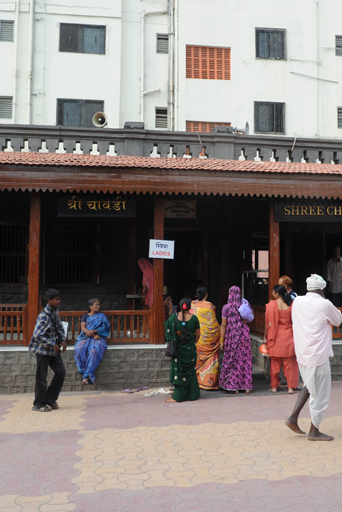
However, we are fortunate that those days are not completely gone. We can experience something of that splendour and fervid devotion even today, as each Thursday evening, a similar procession takes place with Baba’s photo in honour of that tradition. It is a passionate, understrained – yet exalted – celebration of Sai Baba. If you have a chance, be sure to see the procession – it is an exhilarating experience!
In the evening, Baba’s satka and padukas are displayed in front of his sacred tomb from 7.30, until they are carried out at the beginning of the procession at nine O’ clock. The Samadhi Mandir is even more crowded, as people are eager to touch and pay their respects to these sacred objects, which are accessible only at this time. The sense of occasion is enhanced by the hearty singing of melodious bhajan by some villagers, while outside a group of young men from a local youth organization move rhythmically to a rapid drumbeat.
At about 9.15 the procession moves out of the Samadhi Mandir, to a flurry of horns, cries and waving fans. At the centre is the garlanded portrait of Baba (the one from Chavadi) carried reverently by the great-grandson of one of Baba’s dearest devotees, Tatya Kote Patil, and another of his relatives. They are preceded by one of the mandir staff carrying the padukas and satka. Other staff follow, dressed in Maharashtrain-style festive red tunics and turbans. The procession wends its way through the street lined with eagerly waiting crowds, and the music and excitement crescendo as people strain for a glimpse of the photo and padukas. Many throw flowers, and guns fire marigolds, petals and confetti into the air.
The procession enters Dwarkamai about ten minutes later, where again there is an assembled crowd waiting for its arrival and jostling for a view. Here the photo is placed on the decorated silver palanquin to the accompaniment of more exuberant bhajan. This takes about fifteen minutes. Mandir staff and locals then carry the palanquin to Chavadi, where people are waiting inside and out.
As the palanquin approaches Chavadi, we come to the climax of the evening. The palanquin is parked outside, and the picture, draped in gold embroidered red velvet, is carried inside Chavadi and greeted as if Baba himself were entering. People may prostrate (if they have the space !), shout his name, say a silent prayer, or gaze longingly on his face. Baba’s picture is then settled into place on a silver throne and arati is performed. Finally, the whole group returns to the Samadhi Mandir. Here, a local person receives the satka and padukas, and the Kote brothers hand back the picture and collect a coconut as prasad. The prasad is kept beside Baba’s statue until the final night arati is over (around 10.30 p.m.) The picture is returned to Chavadi after morning arati the next day.
During the procession, lalkari is performed at prescribed places along the route. There is no direct translation for “lalkari”, but it means the shouting of slogans or words of praise, such as “Long live Sai Baba!” There are three specific places where this is done during the utsav, just as there were when Baba made the trip by foot, nearly a hundred years ago.
More About Sree Chavadi
The word Chavadi means meeting place of the villagers. Every village in Maharashtra has a Chavadi. The men gather together in the evening to chat wherein they discuss about their crops, their cattle and solve any problem that the village might have. There are two Chavadis in Shirdi; one is south facing where Baba slept on alternate days. Due to a violent storm the devotees forced Baba to sleep there, as the masjid would not withstand the storm’s fury. Baba refused, but perceiving the love and concern of his devotees, he finally agreed. Hence, he stuck to his routine so every alternate day he slept in this Chavadi. The Chavadi procession is described in the Shri Sai Satcharitra Chapter 37.
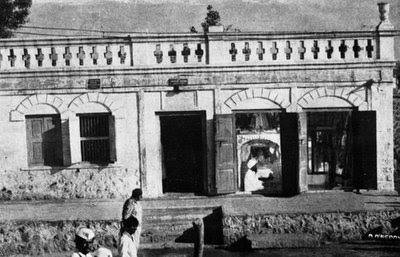
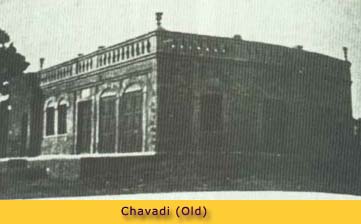
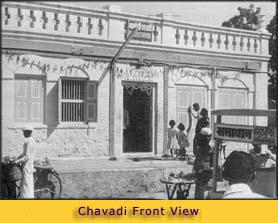
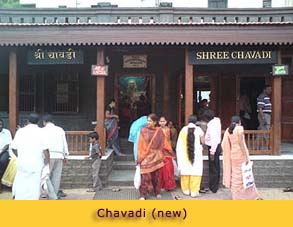
The other Chavadi was north facing, this was used as a reading room. But it is closed and not in use now.
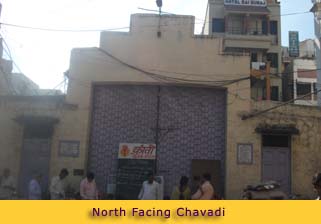
In Shirdi, as in any small village the villagers brought their problems to Baba. It was here that Baba took decisions on true and false statements and acted on the Paap (sinful acts) and Punya (good or righteous deeds). The devotees for their well-being and welfare, made him to go to the Chavadi. Baba did this leaving his tranquil Samadhi state of the Dwaraka Mai. Chavadi is the place for introspection; a court where we have to judge for ourselves and take decisions on what needs to be corrected.
On entering this south facing Chavadi, one can see a plaque on which is inscribed "Shri Sai Nath Babanchi Lakshmi Bai Damodar Babre, Chinchanikar Chavadi, Saka 1859".Damodar Babre came from the village Chinchani in Thane district. Hence, every one called him Anna Chinchanikar. He and his wife came and lived in Shirdi, and were devoted to Baba. For many years they did nishkama seva (selfless service) not expecting or asking for any favours from Baba. One day Shyama asked Baba why He had not blessed this couple with a son while other devotee’s were blessed and their wishes were fulfilled. Baba smiled and said "Has it ever happened, that whenever anybody has asked me for any thing, that I have not granted it"? Baba being Antaryami saw that the son would only continue the name of Anna for one generation. While Baba wanted Anna's name to last for a very very long time.
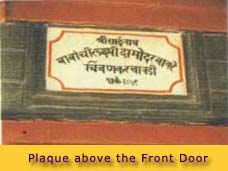
A civil suit regarding his fields was then in progress at Dahanu. Anna time and again asked Baba about the outcome. Baba always replied "Allah Bhala Karega". A famous lawyer, Achyut Narayan Khare, was handling his case. Once someone maliciously wrote to Anna saying that he had lost the case. Anna ran to Kaka Saheb Dixit and informed him; so, both of them came to Baba at Dwarakamai. As they were entering the Dwarakamai, Baba shouted "This old man has no faith in Me, throw away that letter".
Later the lawyer informed him that he had won the case and Rs. 1,800/- along with the court costs was awarded to him. Anna and Kaka Saheb Dixit then went to Baba with the letter in hand. Baba calmly said "Have you got faith in Me now?" Anna placed the letter at Baba's feet and said "Baba this is all yours, I do not want it". Baba refused to accept the money saying that He was a Fakir. Anna begged Baba to accept it. This conversation went on for some time. Ultimately Kaka Saheb Dixit suggested that the sum could be used to repair the Chavadi, and it should be named after Anna and his wife Lakshmi Bai.
In the 1920’s, the Chavadi was a building with three steps leading to it. It had three doors facing south. Then two verandahs were added on either side of the steps. The verandahs are about 13’ long and 8’ wide. In the 1970s, the grills were added. On the Chavadi procession the day’s Arati was performed to Baba, and then Baba was given the chillim to smoke. Now a photograph of Baba is placed on a silver throne (simhasan) and Arati, performed to it. The paintings of the leelas and stories of various Gods and Goddesses were there from Baba’s time.
In the 1920’s, a glass box was placed in front of the photograph with Baba’s padukas in them. This box was there till the 1970’s. In the 1970’s, there were two pairs of padukas kept open for darshan. Then the padukas were kept in the show room of the Samadhi Mandir. After the museum was opened the padukas were kept there. After Baba’s Samadhi, the Chavadi procession is being held by the Sansthan on every Thursday’s and on festival days.
On 9th December 2008, it was the dawn of the 100th year of congregational Arati and palanquin procession. The Shirdi Sai Baba Sansthan had a grand celebration. After Baba’s mangal snan at 6:45 a.m. there was a grand procession, the silver padukas were brought from the Samadhi Mandir to the Chavadi. There Aarati was performed, this was followed by reading of the 37th Chapter of Shri Sai Satcharitra. This chapter has the title “The description of the Chavadi Ceremony”. The villagers along with numerous devotees did “samoohika pathana” (collective reading) of Das Ganu’s Stavana Manjari. Then there was Maha Prasad given by the Sansthan.
CHAVADI PROCESSION
Since 10th December, 1910 devotees began to offer regular worship to Baba in this Chavadi. They brought Him in procession in a regal and royal manner from the Dwarakamai to Chavadi. Even today on Thursdays and other festival days the procession can be seen.
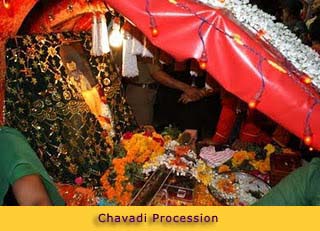
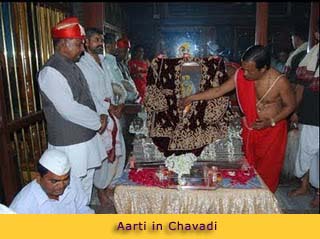
10th December 2010 marked 100th year since the night Arati at Chavadi commenced (Refer Sai Satcharitra Chapter 4 - The story of three wada’ s where in it is stated that the night Arati at Chavadi began on 10th December 1910). The following Arati’s are being specially sung at Chavadi on Thursday’s night (apart from Shej Arati that is performed at Samadhi Mandir)
1. Ghevuniya Panchaarati
2. Aarati Saibaba
3. Shirdi Majhe Pandharapura
4. Ghalina Lotangana
5. Hare Rama Hare Rama
Shirdi Sai baba Palki Procession in Chavadi
THE BIG PAINTING OF BABA ON THE NORTHERN WALL
After His Mahasamadhi Baba gave darshan in the dream of Ambaram Lalbhai Kahar of Navasari in the year 1953. The dream had a tremendous effect on Ambaram, the artist. Then Ambaram painted this portrait of Baba that he got from his dream vision. The painting is 6’ by 4’ of Baba sitting on the stone posture. There is also a gigantic Aum behind Baba.

Ambaram gifted this painting to the Avatar Meher Baba Centre in Navasari. Before this painting was brought to Shirdi, it was placed for public darshan in Navasari. For two days the devotees performed akahand naam jaap of Baba, and simultaneously they had Bhajans throughout the day and night.
The villagers of Navasari were attracted to this portrait and the enchanting leelas of Baba. So they collected subscriptions and got the painting framed. Then after performing puja they brought it to Shirdi in procession and gifted it to the Sansthan.
The Shirdi Saibaba Sansthan first proposed to keep this portrait over Baba’s Samadhi in the Samadhi Mandir. But as Baba’s Idol was being sculpted, this portrait was placed in the Chavadi. It was placed in the place where Baba used to sit during the Shej Arati and Kakad Arati. The Pujari of the Chavadi used to perform Alankar daily with Ashtagandh. This photograph has now been moved to the New Parayan Hall.
THE SMALL PHOTOGRAPH OF BABA ON A SILVER THRONE
This is an original photograph of Baba. It is known as the Raj Upachar photograph. Raj Upachar consists of an elaborate ritual that consists of about 30 smaller rituals including a Snan of various ingredients. They are the Panchamruta Snan and Abhishek. Since all these rituals cannot be performed to a photograph only Panch Upachar is performed.
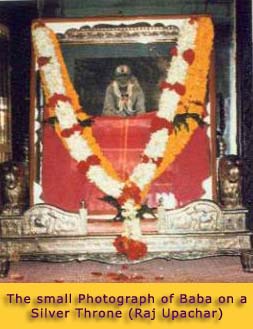
It is taken to the Samadhi Mandir, every Thursday in the afternoon and on other holy days like Ramanavami, Gurupurnima, Vijayadashami. There it is placed on the Samadhi. After Dhoop Arati at 8:45 PM it is taken from Samadhi Mandir in the Palki Procession.
It is the only photograph that has been clad with a Silk Shawl. Baba’s photograph is taken to the Samadhi Mandir where the Pujari does Panch Upachar. The photograph is applied with Gandh or Sandalwood Paste. It is offered Pushpa (flowers), Dhup (Incense), Deepa (Lighted Lamp) and Naivedyam (Offering of food). Then the photograph is clad with the Silk Shawl.
This photograph has been there since Baba's time. Every Thursday after the noon Arati it is brought out and kept on the wooden cot for darshan. Then it is taken to Samadhi Mandir, where after Raj Upachar it is taken in the Palki along with Baba's Padukas and Satka. Arati is done in the Chavadi, and chillim is offered to Baba in this portrait, then taken back to Samadhi Mandir for Shej Arati. It is brought back to the Chavadi, after Kakad Arati the next day.
Chavadi is the place where Baba slept every alternate night. The question that comes to devotee’s mind is “Why did Baba sleep in the Chavadi on alternate nights?”.
The sleeping should be understood at a higher parlance, that is, a state of Samadhi or a rehearsal of death. In death one is alone, as neither spouse nor the children will accompany us. Baba by doing this himself taught us this truth.
Another Question that arises in devotee’s mind is “why women are not allowed in the Sanctum Sanctorum of the Chavadi?”.
The Chavadi is the soul or core of the Jeeva. The human nature is attracted to Kamini, Kanchana and Kashyap. By following this rule strictly, Baba is teaching us not to be trapped by sexual lust. To look at women as mother will ensure spiritual advancement.
Hence, Shri Shirdi Sai Baba Sansthan has restricted the entry of female Sai Devotees to the area in Chavadi where Saibaba used to sleep. Female Sai Devotees should strictly follow this rule when they visit Shirdi for Saibaba Darshan.
Shri Sai Baba Sansthan has now installed the above Rajopachar Photograph at both the entrances (Male and Female entrance) after moving the Photograph given by Ambaram to Parayan Hall.
THE WOODEN COT
After Baba took Mahasamadhi on 15th October, 1918, (Tuesday) at 2.30 PM His body was laid on this wooden cot for three days, till 17th October, 1918 (Thursday). As there were differences between His devotees as to where to intern Him (Ref. ESS, Ch. XLIII & XLIV), on this wooden cot His last bath was performed. With due formalities His body was brought in procession to Dagdi Wada (Samadhi Mandir). In the Garbha Gruha or Santrum Sanctorum i.e. the central portion which was reserved for installation of Murlidhar Idol his Samadhi was made.
This cot was earlier in Dwarakamai but later housed in the Chavadi. This was placed in North West Corner of the Chavadi where ladies are allowed to go. Every Thursday it was taken out and placed in front of the Chavadi and Baba's palki is placed on it. After Arati this cot was placed back along the north western wall of the Chavadi.
But, after the Museum was built, this Wooden Cot was moved there. It is now displayed on the ground floor, in the central area of the Museum.
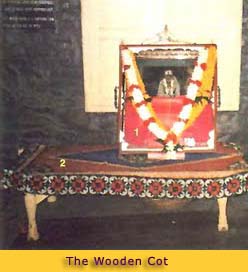
THE WHEEL CHAIR
In 1886 Baba made an attempt to cross the borderline. He suffered from a severe attack of Asthma, and to get rid of it He took samadhi for 72 hours. Mahalsapathi guarded His body well (Ref. ESS, Ch. XLIV). Baba coughed off and on. This chair was presented by a devotee, for Baba to use, and move about in His old age. However, Baba moved freely and occasionally with the help of His devotees. Baba did touch this chair, and kept it, but never made use of it. This chair was placed on the north-western corner of the Chavadi next to the Wooden Cot.
But, after the Museum was built, this Wheel Chair was moved there. It is now displayed on the ground floor, in the central area of the Museum.
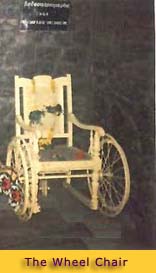
THE GLASS LAMPSHADES (GLASS GLOBES)
Radha Krishna Mayi was a young widow who hailed from Pandharpur. She heard about Baba’s leelas and divinity from Chandorkar. She came to Shirdi and made it her home.
Radha Krishna Mayi loved loved Baba and wanted Him to have a royal Sansthan, which would take care of all the silverware and fine cloths. She tirelessly worked to this end, and often asked rich devotees to bring beautiful articles for Baba. She wanted Baba to enjoy the pomp and show like Lord Vittal of Phandharpur. Kaka Mahajani on the advice of Radha Krishna Mayi brought these glass globes for Baba's lamps in Chavadi. Govardhan Das brought silk curtains and new uniforms for the volunteers who carry the umbrella and chamars (Refer Shirdi Diary, Page.30 by Khaparde).
The daily routine at the Chavadi is given below for the benefit of Sai Devotees:
Chavadi Timings
4:30AM
Chavadi Opens and cleaning is done.
4:45 AM
Offering of Loban.
11:15 AM
Cleaning
11:40 AM
Offering of Loban.
After Evening Arati
The Loban and Live Coal are brought from Samadhi Mandir to Chavadi. The Pujari adds Loban, offers Oil to the Ever Burning Lamps at the time of Sunset.
9:00 PM
Chavadi Closes.
THURSDAY CHAVADI PROCESSION DETAILS:
The “Pitambar” of the “Raj Upachar” photograph is changed with due formalities at about 4.40 AM.
After Noon Aarti at about 12.40 PM the Raj Upachar photo is brought and kept in the Samadhi Mandir. Here this photo is placed along with the Padukas and Satka on the platform of the Baba’s Samadhi.
At 9:15 PM the Chavadi Ustav commences at Samadhi Mandir with the chanting of the below mentioned devotional bhajans:
Alankapuri punya bhumi pavitra
tithe nandato dnyanraja supatra
taya aathavita mahapunya rashi
namskar maza shri sadguru dnyaneshwarasi.
Pundalika Varade hari vittala,
Sri Janadeva, Tukarama, Pandarinath Maharaj Ki Jai,
Sadguru Sainath Maharaj Ki Jai.
Jai Jai Ram Krishna Hari
Jai Jai Ram Jai Jai Ram Krishna Hari
Jai Jai Ram Krishna Hari
Jai Jai Ram Sai Hari
Jai Jai Ram Jai Jai Ram Krishna Hari
Roopa Pahatam Lochaanim.
Sukha Jalem Vo Sajaani.
To Ha Vittala Barava.
To Ha Madhava Barava.
Bahutam Sukrutanchi Jodi
Mhanuni Vittalim Aavadi.
Sarva Sukhachem Agara.
Baapa Rakhumaadevivaroo.
Then the procession proceeds from Samadhi Mandir with the chanting of other bhajans and reaches Dwarakamai around 9:20 PM.
The procession arrives inside Dwakramai around 9:20 PM. The Rajopachar Photograph, Sri Sai Baba’s Paduka and Satka are placed on the Stone on which Baba used to sit. Then the below mentioned devotional bhajans are sung:
Alankapuri punya bhumi pavitra
tithe nandato dnyanraja supatra
taya aathavita mahapunya rashi
namskar maza shri sadguru dnyaneshwarasi.
Pundalika Varade hari vittala,
Sri Janadeva, Tukarama, Pandarinath Maharaj Ki Jai,
Sadguru Sainath Maharaj Ki Jai.
Jai Jai Ram Krishna Hari
Jai Jai Ram Jai Jai Ram Krishna Hari
Jai Jai Ram Krishna Hari
Jai Jai Ram Sai Hari
Jai Jai Ram Jai Jai Ram Krishna Hari
Roopa Pahatam Lochaanim.
Sukha Jalem Vo Sajaani.
To Ha Vittala Barava.
To Ha Madhava Barava.
Bahutam Sukrutanchi Jodi
Mhanuni Vittalim Aavadi.
Sarva Sukhachem Agara.
Baapa Rakhumaadevivaroo.
Sai Nama Sukhadaayi
Sai Nama Ke Do Akshar Mein
Sab Sukh Shanti Samaayi
Sai Nama Sukhadaayi
Hindu Muslim Sikh Isaayi
Sabhko Laage Aas Tumhari
Ashish Dekhar Pavan kardo
Badavo naam ki aas tumhari
Sai Nama Sukhadaayi
Har Dam Tu He Mere Saath
Heen Deen Ka Ekhi Naath
Saidham Ki krupa Hogayi
Pavan Hogayi Kaya Meri
Sai Nama Sukhadaayi
Gopalan Hein Kya Kamal Teri
Pani Mein Tu Jyoth Jalayi
Pani Mein Tu Deep Jalayi
Naa Man Bhoole Tera Koi
Shirdiwaale Baba Sai
Sai Nama Sukhadaayi
Sunder Te Dhyan Ubhe Vitewari.
Kar Katawari Thehuniya.
Tulasi Hara Gala Kanse Pitambara.
Aawde Nirantara Hechi Dhyana.
Makara Kundale Talapti Shrawani
Kanti Koustubhmani Virajita.
Tuka Mahne Majhe Hechi Sarva Sukha.
Aa Pahin Shrimukha Aawadine.
Shirdi Majhe Pandarapura Sai Baba Ramaavara.
Shudha Bhakti Chandrabhaga Bhava Pundalika Jaga.
Yahoyaho Avaghe Jana Karu Babanchi Vandana.
Ganu Mhane Baba Sai Dhav Pav Majhe Aayee.
After the above devotional bhajans, the Rajaopachar photo is brought from the stone on which Baba sat and placed inside the Palanquin.
Then the Goshana Lalkari is sung by Chopdaars as below:
“Shri Gurudeva Shrimanta Maharaaj, Sadguru Sainath Maharaj Ki Jai”
Meaning: Shri Gurudeva (Datta) richest of the richest Shri Sadguru Sainath Maharaj Ki Jai.
Then the Procession starts from Dwarakamai around 9:30 pm with the below bhajan:
Sainatha Guru Majhe Ayi Majala Tava Dhyava Paayi
Majala Tava Dhyava Paayi, Majala Tava Dhyava Paayi
Sainatha Guru Majhe Ayi, Majala Tava Dhayava Paayi
The procession reaches Chavadi around 9:35 PM.
On the arrival of the Palanquin from the Dwarakamai to Chavadi, it is placed on Baba’s cot, which is kept in front of the Chavadi. On this cot Shri Sai Baba's body was kept for 3 days after he attained Mahasamadhi on 15th October 1918. This was followed till the year 2006-2007. But after Shri Sai Baba Sansthan started the Museum in the erstwhile Dikshit Wada, they decided to keep all the original articles used/related to Shri Sai Baba in Museum with a view to preserve them for a longer period of time. Hence, the original cot was kept in the ground floor of the Museum and sealed with a glass cabinet. Now the Sansthan uses a replica of the cot on which Shri Sai Baba's Palanquin is kept.
On every Thursday, after the evening Dhoop Aarti the place in front of Chavadi is thoroughly washed and a big and beautiful Rangoli will be put by a local Sai devotee. When the Palanqin procession comes near Chavadi, The cot and the Palanquin would be placed on the Rangoli with due respect.
The descendants of Tatya have the honor to carry Baba’s photo from the Palanqin into the Chavadi and place it on the Simhasan, while Bayyaji’s descendants carry the Padukas and Satka into the Chavadi for Aarti.
The Rajopachar Photograph of Sai Baba, Paduka and Satka will be placed in the right side of Chavadi where Sri Sai Baba used to sleep every alternate day. Then Dhoop and Panchaarti Deep is offered to Sri Sai Baba followed by Upahara Naivedya.Ater the Naivedya Aarti is performed to Sri Sai Baba.
The Laghu (small) Aarti is performed from 9.30 PM to 9:45 PM. At the beginning of the Aarti is uttered.
Then the below 5 Laghu Aartis are sung:
1. Ghevuniya Panchaarati
2. Aarati Saibaba
3. Shirdi Majhe Pandharapura
4. Ghalina Lotangana
5. Hare Rama Hare Rama
While Aarati Sai Baba is sung the Chillum is offered to Sai Baba Rajopachara Photograph. It is believed that even today during Chavadi Aarti time, Baba comes and smokes the Chillum. If a devotee closely observe when chillum is offered to Baba’s photograph, the flame automatically rise very high as if someone is smoking the Chillium. This is none other than our beloved Sadguru Sai Baba because Baba liked smoking Chillum very much.
At the end of Aarti at Chavadi the Chopdaars utter “Sri Guru Deva Datta”. Then the Goshana Lalkari is sung by Chopdaars as below:
“Shri Gurudeva Shrimanta Maharaaj, Sadguru Sainath Maharaj Ki Jai”
During Shri Sai Baba's sojurn in Shirdi, Tatya used to follow the tradition of applying Attar and Rose Water on Shri Sai Baba during Palanquin procession. (Shri Sai Satcharitra Chapter 37). The same legacy is continued even today by Shri Sai Baba Sansthan Trust (Shirdi) and after the completion of Aarti at Chavadi, descendants of Tatya will apply Attar (Perfume) and Rose Water on Shri Sai Baba's Rajopachar Photograph before it is taken out from Chavadi in procession to the Samadhi Mandir.
The around 9:45 PM the Rajopachar Photo, Paduka and Satka is removed from Chavadi and taken in a Palanquin procession throughout the shirdi village.
After the Chavadi Aarti when the Palanquin and the cot is removed, all the devotees rush towards the Rangoli drawn area and apply the Rangoli on their body thinking that the Rangoli powder is sanctified by Baba since HE sat on that and that by applying the Rangoli powder on their bodies, they will be purified.
Later the Palanquin procession comes back in the end to Samadhi Mandir at 10:30 PM for the Shej Aarti. In this way, the Palanquin returns with the Rajopachar Photograph and Padukas to Samadhi Mandir. The Chavadi closes at about 9:45 PM.
The Chavadi Utsav tradition, the Lalkari Goshana was stared during the sojourn of Shri Sai Baba by none other than Sai Mahabhakte Late Smt.Radhakrishna Maayi on the lines of the tradition that was being followed at Phandarapur for Lord Vittal. She even selected special dresses that used to be put on Sri Sai Baba. Late Smt.Radhakrishna Maayi wanted Sai Baba to be treated on par with Lord Vittal of Pandarapur.
The Rajopachar Photograph comes back to the Chavadi after the Kakad Aarti of the next day.
(Source : Ambrosia in Shirdi and Baba’s Gurukul by Vinny Chitluri and Sri.Nagaraj Anvekar, Bangalore)






CHAVADI PROCESSION
Since 10th December, 1910 devotees began to offer regular worship to Baba in this Chavadi. They brought Him in procession in a regal and royal manner from the Dwarakamai to Chavadi. Even today on Thursdays and other festival days the procession can be seen.


10th December 2010 marked 100th year since the night Arati at Chavadi commenced (Refer Sai Satcharitra Chapter 4 - The story of three wada’ s where in it is stated that the night Arati at Chavadi began on 10th December 1910). The following Arati’s are being specially sung at Chavadi on Thursday’s night (apart from Shej Arati that is performed at Samadhi Mandir) 1. Ghevuniya Panchaarati 2. Aarati Saibaba 3. Shirdi Majhe Pandharapura 4. Ghalina Lotangana 5. Hare Rama Hare Rama
Shirdi Sai baba Palki Procession in Chavadi
THE BIG PAINTING OF BABA ON THE NORTHERN WALL
After His Mahasamadhi Baba gave darshan in the dream of Ambaram Lalbhai Kahar of Navasari in the year 1953. The dream had a tremendous effect on Ambaram, the artist. Then Ambaram painted this portrait of Baba that he got from his dream vision. The painting is 6’ by 4’ of Baba sitting on the stone posture. There is also a gigantic Aum behind Baba.

Ambaram gifted this painting to the Avatar Meher Baba Centre in Navasari. Before this painting was brought to Shirdi, it was placed for public darshan in Navasari. For two days the devotees performed akahand naam jaap of Baba, and simultaneously they had Bhajans throughout the day and night. The villagers of Navasari were attracted to this portrait and the enchanting leelas of Baba. So they collected subscriptions and got the painting framed. Then after performing puja they brought it to Shirdi in procession and gifted it to the Sansthan. The Shirdi Saibaba Sansthan first proposed to keep this portrait over Baba’s Samadhi in the Samadhi Mandir. But as Baba’s Idol was being sculpted, this portrait was placed in the Chavadi. It was placed in the place where Baba used to sit during the Shej Arati and Kakad Arati. The Pujari of the Chavadi used to perform Alankar daily with Ashtagandh. This photograph has now been moved to the New Parayan Hall.
THE SMALL PHOTOGRAPH OF BABA ON A SILVER THRONE
This is an original photograph of Baba. It is known as the Raj Upachar photograph. Raj Upachar consists of an elaborate ritual that consists of about 30 smaller rituals including a Snan of various ingredients. They are the Panchamruta Snan and Abhishek. Since all these rituals cannot be performed to a photograph only Panch Upachar is performed.

It is taken to the Samadhi Mandir, every Thursday in the afternoon and on other holy days like Ramanavami, Gurupurnima, Vijayadashami. There it is placed on the Samadhi. After Dhoop Arati at 8:45 PM it is taken from Samadhi Mandir in the Palki Procession. It is the only photograph that has been clad with a Silk Shawl. Baba’s photograph is taken to the Samadhi Mandir where the Pujari does Panch Upachar. The photograph is applied with Gandh or Sandalwood Paste. It is offered Pushpa (flowers), Dhup (Incense), Deepa (Lighted Lamp) and Naivedyam (Offering of food). Then the photograph is clad with the Silk Shawl. This photograph has been there since Baba's time. Every Thursday after the noon Arati it is brought out and kept on the wooden cot for darshan. Then it is taken to Samadhi Mandir, where after Raj Upachar it is taken in the Palki along with Baba's Padukas and Satka. Arati is done in the Chavadi, and chillim is offered to Baba in this portrait, then taken back to Samadhi Mandir for Shej Arati. It is brought back to the Chavadi, after Kakad Arati the next day. Chavadi is the place where Baba slept every alternate night. The question that comes to devotee’s mind is “Why did Baba sleep in the Chavadi on alternate nights?”. The sleeping should be understood at a higher parlance, that is, a state of Samadhi or a rehearsal of death. In death one is alone, as neither spouse nor the children will accompany us. Baba by doing this himself taught us this truth. Another Question that arises in devotee’s mind is “why women are not allowed in the Sanctum Sanctorum of the Chavadi?”. The Chavadi is the soul or core of the Jeeva. The human nature is attracted to Kamini, Kanchana and Kashyap. By following this rule strictly, Baba is teaching us not to be trapped by sexual lust. To look at women as mother will ensure spiritual advancement. Hence, Shri Shirdi Sai Baba Sansthan has restricted the entry of female Sai Devotees to the area in Chavadi where Saibaba used to sleep. Female Sai Devotees should strictly follow this rule when they visit Shirdi for Saibaba Darshan. Shri Sai Baba Sansthan has now installed the above Rajopachar Photograph at both the entrances (Male and Female entrance) after moving the Photograph given by Ambaram to Parayan Hall.
THE WOODEN COT
After Baba took Mahasamadhi on 15th October, 1918, (Tuesday) at 2.30 PM His body was laid on this wooden cot for three days, till 17th October, 1918 (Thursday). As there were differences between His devotees as to where to intern Him (Ref. ESS, Ch. XLIII & XLIV), on this wooden cot His last bath was performed. With due formalities His body was brought in procession to Dagdi Wada (Samadhi Mandir). In the Garbha Gruha or Santrum Sanctorum i.e. the central portion which was reserved for installation of Murlidhar Idol his Samadhi was made. This cot was earlier in Dwarakamai but later housed in the Chavadi. This was placed in North West Corner of the Chavadi where ladies are allowed to go. Every Thursday it was taken out and placed in front of the Chavadi and Baba's palki is placed on it. After Arati this cot was placed back along the north western wall of the Chavadi. But, after the Museum was built, this Wooden Cot was moved there. It is now displayed on the ground floor, in the central area of the Museum.

THE WHEEL CHAIR
In 1886 Baba made an attempt to cross the borderline. He suffered from a severe attack of Asthma, and to get rid of it He took samadhi for 72 hours. Mahalsapathi guarded His body well (Ref. ESS, Ch. XLIV). Baba coughed off and on. This chair was presented by a devotee, for Baba to use, and move about in His old age. However, Baba moved freely and occasionally with the help of His devotees. Baba did touch this chair, and kept it, but never made use of it. This chair was placed on the north-western corner of the Chavadi next to the Wooden Cot. But, after the Museum was built, this Wheel Chair was moved there. It is now displayed on the ground floor, in the central area of the Museum.

THE GLASS LAMPSHADES (GLASS GLOBES)
Radha Krishna Mayi was a young widow who hailed from Pandharpur. She heard about Baba’s leelas and divinity from Chandorkar. She came to Shirdi and made it her home. Radha Krishna Mayi loved loved Baba and wanted Him to have a royal Sansthan, which would take care of all the silverware and fine cloths. She tirelessly worked to this end, and often asked rich devotees to bring beautiful articles for Baba. She wanted Baba to enjoy the pomp and show like Lord Vittal of Phandharpur. Kaka Mahajani on the advice of Radha Krishna Mayi brought these glass globes for Baba's lamps in Chavadi. Govardhan Das brought silk curtains and new uniforms for the volunteers who carry the umbrella and chamars (Refer Shirdi Diary, Page.30 by Khaparde). The daily routine at the Chavadi is given below for the benefit of Sai Devotees:
Chavadi Timings
| 4:30AM | Chavadi Opens and cleaning is done. |
|---|---|
| 4:45 AM | Offering of Loban. |
| 11:15 AM | Cleaning |
| 11:40 AM | Offering of Loban. |
| After Evening Arati | The Loban and Live Coal are brought from Samadhi Mandir to Chavadi. The Pujari adds Loban, offers Oil to the Ever Burning Lamps at the time of Sunset. |
| 9:00 PM | Chavadi Closes. |
THURSDAY CHAVADI PROCESSION DETAILS:
The “Pitambar” of the “Raj Upachar” photograph is changed with due formalities at about 4.40 AM. After Noon Aarti at about 12.40 PM the Raj Upachar photo is brought and kept in the Samadhi Mandir. Here this photo is placed along with the Padukas and Satka on the platform of the Baba’s Samadhi. At 9:15 PM the Chavadi Ustav commences at Samadhi Mandir with the chanting of the below mentioned devotional bhajans:
Alankapuri punya bhumi pavitra tithe nandato dnyanraja supatra taya aathavita mahapunya rashi namskar maza shri sadguru dnyaneshwarasi. Pundalika Varade hari vittala, Sri Janadeva, Tukarama, Pandarinath Maharaj Ki Jai, Sadguru Sainath Maharaj Ki Jai. Jai Jai Ram Krishna Hari Jai Jai Ram Jai Jai Ram Krishna Hari Jai Jai Ram Krishna Hari Jai Jai Ram Sai Hari Jai Jai Ram Jai Jai Ram Krishna Hari Roopa Pahatam Lochaanim. Sukha Jalem Vo Sajaani. To Ha Vittala Barava. To Ha Madhava Barava. Bahutam Sukrutanchi Jodi Mhanuni Vittalim Aavadi. Sarva Sukhachem Agara. Baapa Rakhumaadevivaroo.
Then the procession proceeds from Samadhi Mandir with the chanting of other bhajans and reaches Dwarakamai around 9:20 PM. The procession arrives inside Dwakramai around 9:20 PM. The Rajopachar Photograph, Sri Sai Baba’s Paduka and Satka are placed on the Stone on which Baba used to sit. Then the below mentioned devotional bhajans are sung:
Alankapuri punya bhumi pavitra tithe nandato dnyanraja supatra taya aathavita mahapunya rashi namskar maza shri sadguru dnyaneshwarasi. Pundalika Varade hari vittala, Sri Janadeva, Tukarama, Pandarinath Maharaj Ki Jai, Sadguru Sainath Maharaj Ki Jai. Jai Jai Ram Krishna Hari Jai Jai Ram Jai Jai Ram Krishna Hari Jai Jai Ram Krishna Hari Jai Jai Ram Sai Hari Jai Jai Ram Jai Jai Ram Krishna Hari Roopa Pahatam Lochaanim. Sukha Jalem Vo Sajaani. To Ha Vittala Barava. To Ha Madhava Barava. Bahutam Sukrutanchi Jodi Mhanuni Vittalim Aavadi. Sarva Sukhachem Agara. Baapa Rakhumaadevivaroo. Sai Nama Sukhadaayi Sai Nama Ke Do Akshar Mein Sab Sukh Shanti Samaayi Sai Nama Sukhadaayi Hindu Muslim Sikh Isaayi Sabhko Laage Aas Tumhari Ashish Dekhar Pavan kardo Badavo naam ki aas tumhari Sai Nama Sukhadaayi Har Dam Tu He Mere Saath Heen Deen Ka Ekhi Naath Saidham Ki krupa Hogayi Pavan Hogayi Kaya Meri Sai Nama Sukhadaayi Gopalan Hein Kya Kamal Teri Pani Mein Tu Jyoth Jalayi Pani Mein Tu Deep Jalayi Naa Man Bhoole Tera Koi Shirdiwaale Baba Sai Sai Nama Sukhadaayi Sunder Te Dhyan Ubhe Vitewari. Kar Katawari Thehuniya. Tulasi Hara Gala Kanse Pitambara. Aawde Nirantara Hechi Dhyana. Makara Kundale Talapti Shrawani Kanti Koustubhmani Virajita. Tuka Mahne Majhe Hechi Sarva Sukha. Aa Pahin Shrimukha Aawadine. Shirdi Majhe Pandarapura Sai Baba Ramaavara. Shudha Bhakti Chandrabhaga Bhava Pundalika Jaga. Yahoyaho Avaghe Jana Karu Babanchi Vandana. Ganu Mhane Baba Sai Dhav Pav Majhe Aayee.
After the above devotional bhajans, the Rajaopachar photo is brought from the stone on which Baba sat and placed inside the Palanquin.
Then the Goshana Lalkari is sung by Chopdaars as below:
“Shri Gurudeva Shrimanta Maharaaj, Sadguru Sainath Maharaj Ki Jai”
Meaning: Shri Gurudeva (Datta) richest of the richest Shri Sadguru Sainath Maharaj Ki Jai.
Then the Procession starts from Dwarakamai around 9:30 pm with the below bhajan:
Sainatha Guru Majhe Ayi Majala Tava Dhyava Paayi
Majala Tava Dhyava Paayi, Majala Tava Dhyava Paayi
Sainatha Guru Majhe Ayi, Majala Tava Dhayava Paayi
The procession reaches Chavadi around 9:35 PM.
On the arrival of the Palanquin from the Dwarakamai to Chavadi, it is placed on Baba’s cot, which is kept in front of the Chavadi. On this cot Shri Sai Baba's body was kept for 3 days after he attained Mahasamadhi on 15th October 1918. This was followed till the year 2006-2007. But after Shri Sai Baba Sansthan started the Museum in the erstwhile Dikshit Wada, they decided to keep all the original articles used/related to Shri Sai Baba in Museum with a view to preserve them for a longer period of time. Hence, the original cot was kept in the ground floor of the Museum and sealed with a glass cabinet. Now the Sansthan uses a replica of the cot on which Shri Sai Baba's Palanquin is kept.
On every Thursday, after the evening Dhoop Aarti the place in front of Chavadi is thoroughly washed and a big and beautiful Rangoli will be put by a local Sai devotee. When the Palanqin procession comes near Chavadi, The cot and the Palanquin would be placed on the Rangoli with due respect.
The descendants of Tatya have the honor to carry Baba’s photo from the Palanqin into the Chavadi and place it on the Simhasan, while Bayyaji’s descendants carry the Padukas and Satka into the Chavadi for Aarti.
The Rajopachar Photograph of Sai Baba, Paduka and Satka will be placed in the right side of Chavadi where Sri Sai Baba used to sleep every alternate day. Then Dhoop and Panchaarti Deep is offered to Sri Sai Baba followed by Upahara Naivedya.Ater the Naivedya Aarti is performed to Sri Sai Baba.
The Laghu (small) Aarti is performed from 9.30 PM to 9:45 PM. At the beginning of the Aarti is uttered.
Then the below 5 Laghu Aartis are sung:
1. Ghevuniya Panchaarati
2. Aarati Saibaba
3. Shirdi Majhe Pandharapura
4. Ghalina Lotangana
5. Hare Rama Hare Rama
While Aarati Sai Baba is sung the Chillum is offered to Sai Baba Rajopachara Photograph. It is believed that even today during Chavadi Aarti time, Baba comes and smokes the Chillum. If a devotee closely observe when chillum is offered to Baba’s photograph, the flame automatically rise very high as if someone is smoking the Chillium. This is none other than our beloved Sadguru Sai Baba because Baba liked smoking Chillum very much.
At the end of Aarti at Chavadi the Chopdaars utter “Sri Guru Deva Datta”. Then the Goshana Lalkari is sung by Chopdaars as below:
“Shri Gurudeva Shrimanta Maharaaj, Sadguru Sainath Maharaj Ki Jai”
During Shri Sai Baba's sojurn in Shirdi, Tatya used to follow the tradition of applying Attar and Rose Water on Shri Sai Baba during Palanquin procession. (Shri Sai Satcharitra Chapter 37). The same legacy is continued even today by Shri Sai Baba Sansthan Trust (Shirdi) and after the completion of Aarti at Chavadi, descendants of Tatya will apply Attar (Perfume) and Rose Water on Shri Sai Baba's Rajopachar Photograph before it is taken out from Chavadi in procession to the Samadhi Mandir.
The around 9:45 PM the Rajopachar Photo, Paduka and Satka is removed from Chavadi and taken in a Palanquin procession throughout the shirdi village.
After the Chavadi Aarti when the Palanquin and the cot is removed, all the devotees rush towards the Rangoli drawn area and apply the Rangoli on their body thinking that the Rangoli powder is sanctified by Baba since HE sat on that and that by applying the Rangoli powder on their bodies, they will be purified.
Later the Palanquin procession comes back in the end to Samadhi Mandir at 10:30 PM for the Shej Aarti. In this way, the Palanquin returns with the Rajopachar Photograph and Padukas to Samadhi Mandir. The Chavadi closes at about 9:45 PM.
The Chavadi Utsav tradition, the Lalkari Goshana was stared during the sojourn of Shri Sai Baba by none other than Sai Mahabhakte Late Smt.Radhakrishna Maayi on the lines of the tradition that was being followed at Phandarapur for Lord Vittal. She even selected special dresses that used to be put on Sri Sai Baba. Late Smt.Radhakrishna Maayi wanted Sai Baba to be treated on par with Lord Vittal of Pandarapur.
The Rajopachar Photograph comes back to the Chavadi after the Kakad Aarti of the next day.
(Source : Ambrosia in Shirdi and Baba’s Gurukul by Vinny Chitluri and Sri.Nagaraj Anvekar, Bangalore)
On the arrival of the Palanquin from the Dwarakamai to Chavadi, it is placed on Baba’s cot, which is kept in front of the Chavadi. On this cot Shri Sai Baba's body was kept for 3 days after he attained Mahasamadhi on 15th October 1918. This was followed till the year 2006-2007. But after Shri Sai Baba Sansthan started the Museum in the erstwhile Dikshit Wada, they decided to keep all the original articles used/related to Shri Sai Baba in Museum with a view to preserve them for a longer period of time. Hence, the original cot was kept in the ground floor of the Museum and sealed with a glass cabinet. Now the Sansthan uses a replica of the cot on which Shri Sai Baba's Palanquin is kept. On every Thursday, after the evening Dhoop Aarti the place in front of Chavadi is thoroughly washed and a big and beautiful Rangoli will be put by a local Sai devotee. When the Palanqin procession comes near Chavadi, The cot and the Palanquin would be placed on the Rangoli with due respect. The descendants of Tatya have the honor to carry Baba’s photo from the Palanqin into the Chavadi and place it on the Simhasan, while Bayyaji’s descendants carry the Padukas and Satka into the Chavadi for Aarti. The Rajopachar Photograph of Sai Baba, Paduka and Satka will be placed in the right side of Chavadi where Sri Sai Baba used to sleep every alternate day. Then Dhoop and Panchaarti Deep is offered to Sri Sai Baba followed by Upahara Naivedya.Ater the Naivedya Aarti is performed to Sri Sai Baba. The Laghu (small) Aarti is performed from 9.30 PM to 9:45 PM. At the beginning of the Aarti is uttered. Then the below 5 Laghu Aartis are sung:
At the end of Aarti at Chavadi the Chopdaars utter “Sri Guru Deva Datta”. Then the Goshana Lalkari is sung by Chopdaars as below:
